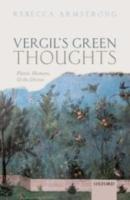
OUP (2019) h/b 352pp £75 (ISBN 9780199236688)
That plants play a prominent rôle in Vergil’s poetry is clear from a cursory reading of his works, whether to help create atmosphere, bring out the symbolic meaning of more elaborate scenes or even take a part in the action. Just how prominent a rôle, however, is amply demonstrated by this contribution to the growing field of scholarly interest in literature’s relations with the natural world.
The extensive introduction sets out the background to the author’s study. It touches upon the approaches to ancient botany in Greek texts like those of Aristotle and Theophrastus and in Roman agricultural works by Cato and Varro. It also sets out basic definitions of the word ‘nature’, and discusses topics such as the anthropocentric world view of nature as subservient to humans and their needs, ancient attitudes towards environmentalism, nature’s divine connections with both wild and cultivated lands, the influence on Vergil’s thought of Hesiod, Theocritus and Lucretius, comparisons between humans and plants, and plants’ political symbolism.
Thereafter the book is divided into two main parts: Numen and Homo, structured so as to take account of rational/non-rational and sympathetic/antipathetic reactions to plants, both tame and wild.
Numen deals with the religious and supernatural aspects of nature with respect to groves and forests, both on the earth and in the underworld, vineyards, arable fields, meadows and orchards. It demonstrates gods’ particular links with certain plants like the oak, laurel, pine and olive, and differentiates between the idealised wooded countryside of the Eclogues, where the inhabitants maintain a comfortable and familiar relationship with their pastoral gods, the cultivated fields of the Georgics, strongly associated with Ceres and Bacchus, and the groves and woodlands of the Aeneid, presided over by both Olympian and local Italian deities.
Other topics treated include the use of plants to maintain good relations between men and gods, humans turning into plants and magical and medicinal flora like the poppy, demonstrating the complexity of the landscape of Vergilian, and indeed Roman, religious thought, along with the basic continuity of Vergil’s approach to nature throughout his works, despite greater frequency of references in the earlier poetry.
Homo is focussed on how humans interact with and use cereal crops, fruit trees and plants for animal fodder, including the use of trees for shade, vine supports, shipbuilding, ploughs, weapons, wheels and wagons, as well as moral and philosophical undertones concerning their cultivation. Sections deal with the mutual dependence of humans and crops, the harmony and conflict of man’s relationship with them and the impact on men’s self-image as the dominant species, able to use nature as it pleases. Also discussed are human attitudes to wild plants, the considerable overlap between the wild and the tame, the symbolism of flowers and comparisons with human beauty and sexuality, the degeneration and degeneracy of plants and differing interpretations concerning weeds, brambles and grasses.
The author concludes that Vergil shows a greater interest in plants than most ancient poets and that they make a significant contribution to the themes of his poetry, but she also highlights the tensions and contradictions co-existing in the complexity and variety of his many references to the natural world.
This is a highly specialised study recommended for an academic and scholarly audience only. All the Latin and Greek is translated into English, but the implications of the frequent close readings of passages would be difficult to comprehend fully without specialist language skills.
Claire Gruzelier
